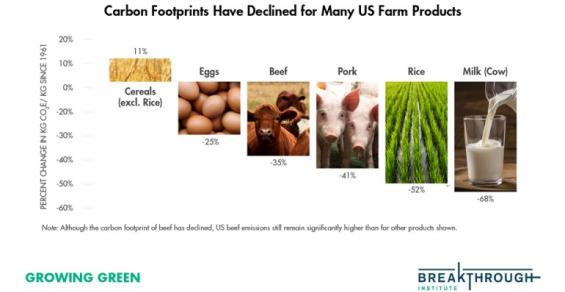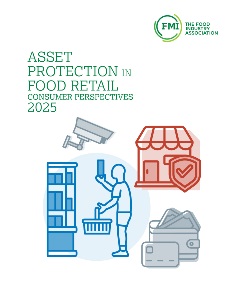Largely due to a history of agricultural research and development, growth in agricultural productivity has reduced food prices; cut the carbon footprint of milk, chicken, beef, and many other products; reduced land use; and led to more efficient use of many resources. But after years of steady growth, public agricultural R&D funding in the United States is waning and could impact farmers’ competitiveness as well as impact the environment.
The Breakthrough Institute released a new report detailing how two decades of declining investment in public agricultural research puts the U.S. economy and the climate at risk. The report authors, Breakthrough Senior Food and Agriculture Analyst Alex Smith and Director of the Food and Agriculture Program Dan Blaustein Rejto, describe research and development’s historical contribution to agricultural modernization and assess how public agricultural R&D can continue to drive significant climate and economic benefits.
“With the fast-paced development of key knowledge, technologies, and practices, agricultural modernization has led to unprecedented levels of agricultural productivity. As described in the report, productivity growth has, in turn, reduced food prices, reduced land use, led to more efficient use of inputs, and cut the carbon footprint of milk, chicken, beef, and many other products,” says Smith.
The report notes, as an example, if U.S. corn yields had remained stagnant from 1961 to 2020, corn farmers would have needed additional land the size of France to produce the same total amount of corn in 2020. Although yield gains in that period were partially due to greater use of fertilizer, fuel, and other energy-intensive farm inputs, the carbon footprint of key agricultural goods declined.
Federal R&D contributes to solutions that can diminish the risk of climate-related food insecurity, improve the competitiveness of U.S. farmers, keep food prices low, and reduce the overall greenhouse gas and land-use footprint of the global food system. Not to mention, research has shown that every dollar spent on public agricultural R&D has, on average, generated $20 in benefits for consumers and the broader U.S. economy, the report states.
Yet, public investment in agricultural research has stagnated or even declined. The authors note that public agricultural R&D investment has declined by one-third, in real dollars, since 2000 and has fallen as a portion of total US R&D investment. In 1960, the United States was far and away the world leader in public agricultural R&D spending–accounting for 20% of global public funding in that area. Since then, the United States has fallen behind. In 2015, the United States accounted for only 8.9% of global public R&D spending in agriculture, taking second place to China, with 14.5%.
Since 1950, the public share of U.S. agricultural R&D spending went from 65.1% of total agricultural R&D spending in the country to 31.3% in 2017. While private agricultural R&D has increased, it tends to focus more on commercial opportunities and less on long-term, productivity-enhancing research.
“Allowing public R&D investment to continue to fall undermines American farmers’ ability to address increasing global competition and new threats, such as climate change, geopolitical strife, and the COVID-19 pandemic,” explains Blaustein-Rejto.
Total funds allocated for U.S. public agricultural R&D, including by the USDA, other federal agencies, state governments, and non-government funders, was $5.04 billion in 2019, the most recent year for which amounts are available. The USDA administered $2.77 billion through the National Institute of Food and Agriculture, the Agricultural Research Service, and smaller agricultural R&D agencies and programs.
Two other NIFA programs are the Specialty Crop Research Initiative and the Organic Agriculture Research and Extension Initiative. NIFA also provides funding for the Sustainable Agriculture Research and Education program and other smaller research initiatives.
Given such benefits, the report authors encourage Congress to at least double funding for agricultural R&D, bolstering well-established agencies such as the Agricultural Research Service and National Institute of Food and Agriculture, as well as expanding newer efforts such as the Foundation for Food & Agriculture Research and the Agriculture Advanced Research and Development Authority. Doing so would entail at least an additional $3.4 billion in annual funding.
“This additional support should be directed, in particular, toward areas that increase productivity and reduce agriculture’s carbon footprint while addressing other environmental concerns,” the report notes. “These R&D priorities include livestock breeding; genetic engineering; developing crops with deeper roots that sequester more carbon; improving meat and dairy alternatives; and creating low-carbon fertilizers that generate less runoff.”
The analysis commissioned by the Breakthrough Institute projects that doubling public U.S. agricultural R&D spending would reduce global emissions by 213 million metric tons of carbon dioxide-equivalent per year, corresponding to over one-third of current US agricultural emissions. This mitigation would cost about $12 per ton of abated emissions, less than many other climate policies, while generating other benefits such as increased domestic agricultural production and lower prices.
New report “Growing Green” analyzes the environmental benefits of public research and development and the need to double ag R&D spending.





